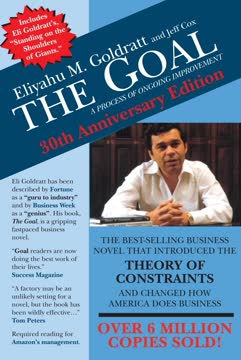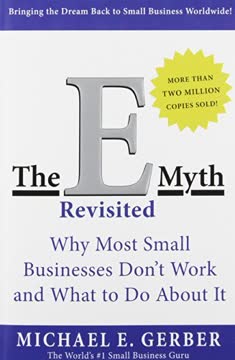النقاط الرئيسية
1. التقط كل ما يشغل انتباهك
عقلك مخصص لتوليد الأفكار، وليس للاحتفاظ بها.
اجمع كل الحلقات المفتوحة. اجمع كل مهمة، التزام، وفكرة تشغل حيزًا في عقلك. يشمل ذلك الالتزامات الشخصية والمهنية، من المشاريع الكبيرة إلى المهام الصغيرة. استخدم الأدوات المادية والرقمية مثل الدفاتر، التطبيقات، أو المذكرات الصوتية لتفريغ هذه الأفكار.
أنشئ عادة التجميع. قم بتفريغ عقلك بانتظام من كل محتوياته. هذه الممارسة تقلل من التوتر والفوضى العقلية، مما يسمح لك بالتركيز على ما هو مهم حقًا. من خلال التقاط كل شيء، تحرر عرض النطاق الترددي العقلي وتضمن عدم سقوط أي شيء من خلال الشقوق.
ثق في العملية. في البداية، قد يبدو هذا مرهقًا عندما تواجه حجم التزاماتك. ومع ذلك، فإن إخراج كل شيء من رأسك هو الخطوة الأولى نحو السيطرة والوضوح. تذكر، أنك لا تلتزم بفعل كل ما تلتقطه، بل تعترف بوجوده فقط.
2. وضح النتيجة المرجوة والخطوة التالية لكل عنصر
سر التقدم هو البدء. سر البدء هو تقسيم المهام المعقدة المرهقة إلى مهام صغيرة قابلة للإدارة، ثم البدء في الأولى.
حدد نتائج واضحة. لكل عنصر قمت بالتقاطه، حدد ما يبدو عليه "الإنجاز". هذا الوضوح يساعد عقلك على التركيز على تحقيق النتيجة المرجوة بدلاً من مجرد التفكير في المشكلة.
حدد الخطوات التالية. قسم كل نتيجة إلى إجراءات محددة وملموسة. اسأل نفسك، "ما هي الخطوة التالية التي أحتاج إلى اتخاذها لتحريك هذا الأمر إلى الأمام؟" هذه الخطوة تحول الأفكار الغامضة إلى مهام ملموسة وقابلة للتنفيذ.
أمثلة على الخطوات التالية:
- اتصل بجون بشأن جدول المشروع
- اكتب مخطط العرض التقديمي
- ابحث عن خيارات الطيران للرحلة القادمة
3. نظم التذكيرات في نظام موثوق
قدرتك على توليد القوة تتناسب طرديًا مع قدرتك على الاسترخاء.
أنشئ نظامًا تنظيميًا موثوقًا. طور هيكلًا يسمح لك بتخزين واسترجاع المعلومات بسهولة. قد يشمل ذلك الأدوات الرقمية مثل تطبيقات إدارة المهام أو الأنظمة المادية مثل ملفات المجلدات.
صنف حسب السياق. اجمع المهام بناءً على المكان أو كيفية إتمامها. تشمل الفئات الشائعة:
- @الكمبيوتر
- @الهاتف
- @المهام
- @المنزل
- @المكتب
احتفظ بقوائم منفصلة. احتفظ بقوائم مميزة لأنواع مختلفة من العناصر:
- الخطوات التالية: مهام فورية وملموسة
- المشاريع: نتائج متعددة الخطوات
- في انتظار: عناصر مفوضة للآخرين
- يومًا ما/ربما: أفكار للمستقبل
4. راجع وحدث نظامك بانتظام
من الأسهل أن تتصرف بطريقة تجعلك تشعر بشكل أفضل من أن تشعر بطريقة تجعلك تتصرف بشكل أفضل.
قم بمراجعة أسبوعية. خصص وقتًا كل أسبوع لمراجعة وتحديث نظامك. هذه العادة تضمن بقاء قوائمك حديثة وذات صلة.
عملية المراجعة الأسبوعية:
- اجمع كل الأوراق والمواد المتناثرة
- عالج ملاحظاتك
- راجع بيانات التقويم السابقة
- راجع التقويم القادم
- راجع قوائم الإجراءات
- راجع قوائم المشاريع
حافظ على المنظور. استخدم هذا الوقت لتقييم التزاماتك على مستويات مختلفة، من الإجراءات اليومية إلى أهداف الحياة. هذه الممارسة تساعدك على البقاء متوافقًا مع أهدافك الأوسع أثناء إدارة المهام اليومية.
5. اتخذ إجراءات بشأن مهامك الأكثر أهمية
الحظ يؤثر على كل شيء. دع صنارتك دائمًا تكون ملقاة؛ في التيار حيث لا تتوقعه، سيكون هناك سمكة.
طبق قاعدة الدقيقتين. إذا كانت المهمة تستغرق أقل من دقيقتين، قم بها فورًا. هذه القاعدة تمنع تراكم المهام الصغيرة وتسد نظامك.
استخدم نموذج المعايير الأربعة لاختيار الإجراءات:
- السياق: ما الذي يمكنك فعله بالنظر إلى موقعك الحالي والأدوات المتاحة؟
- الوقت المتاح: كم من الوقت لديك قبل التزامك التالي؟
- الطاقة المتاحة: ما هو مستوى الطاقة العقلية والجسدية لديك؟
- الأولوية: بالنظر إلى العوامل السابقة، ما هو الشيء الأكثر أهمية للقيام به؟
ثق في حدسك. بمجرد أن يكون لديك نظرة عامة واضحة على التزاماتك والخطوات التالية، ثق في حدسك عند اتخاذ قرار بشأن ما يجب العمل عليه. عقلك يكون حرًا لاتخاذ قرارات بديهية عندما لا يكون مشوشًا بالمدخلات غير المعالجة.
6. اتقن فن الإنتاجية الخالية من التوتر
هناك شيء واحد يمكننا القيام به، وأسعد الناس هم الذين يمكنهم القيام به إلى أقصى حد. يمكننا أن نكون حاضرين تمامًا. يمكننا أن نكون هنا بالكامل. يمكننا... أن نولي كل انتباهنا للفرصة التي أمامنا.
حقق عقلًا مثل الماء. اسعَ لتحقيق حالة من الجاهزية والمرونة، مثل الماء الذي يتكيف مع أي وعاء. هذه العقلية تسمح لك بالاستجابة بشكل مناسب لأي شيء تلقيه الحياة عليك، دون المبالغة في رد الفعل أو التقليل منه.
تخلص من السحب النفسي. من خلال التقاط وتوضيح جميع التزاماتك، تزيل التوتر الخفي الناجم عن المهام غير المكتملة والالتزامات غير الواضحة. هذا يحرر الطاقة العقلية للعمل المركز والإبداع.
مارس التفكير في النتائج. تصور بانتظام النتائج الناجحة لمشاريعك وأهدافك. هذه العادة تهيئ عقلك لملاحظة الفرص والحلول التي تتماشى مع النتائج المرجوة.
7. حول نهجك للعمل والحياة
كيف أعرف ما أفكر فيه، حتى أسمع ما أقوله؟
انتقل من إدارة الوقت إلى إدارة التركيز. بدلاً من محاولة ضغط المزيد في كل يوم، ركز على توجيه انتباهك بفعالية. هذا النهج يعترف بأن الطاقة والانتباه، وليس الوقت فقط، هما موارد حاسمة.
تبنى عقلية "الخطوة التالية". درب نفسك ومن حولك على تحديد الخطوة المادية والمرئية التالية المطلوبة لتحريك شيء ما إلى الأمام. هذه العادة تمنع التسويف وتحافظ على تدفق المشاريع.
ازرع ميلاً نحو العمل. طور عادة اتخاذ الإجراءات الفورية على المهام الصغيرة واتخاذ قرارات سريعة بشأن الخطوات التالية للمشاريع الكبيرة. هذا النهج الاستباقي يبني الزخم والثقة.
أنشئ نظامًا موثوقًا منخفض المقاومة. صمم نظامك التنظيمي ليكون بسيطًا وممتعًا للاستخدام بحيث تتفاعل معه بشكل طبيعي. كلما كان من الأسهل التقاط، توضيح، ومراجعة، زادت احتمالية الحفاظ على النظام.
آخر تحديث::
FAQ
What's "Getting Things Done: The Art of Stress-Free Productivity" about?
- Overview: "Getting Things Done" by David Allen is a guide to organizing tasks and commitments to achieve stress-free productivity. It introduces a system to manage work and life efficiently.
- Main Focus: The book emphasizes capturing all tasks and commitments in a trusted system outside the mind, clarifying actions, and organizing them for review and execution.
- Purpose: It aims to help individuals clear their minds of clutter and focus on completing tasks effectively, providing a structured approach to managing tasks, projects, and responsibilities.
- Target Audience: Ideal for anyone feeling overwhelmed by their workload, from executives to homemakers, offering practical advice to regain control and clarity.
Why should I read "Getting Things Done"?
- Improved Productivity: The book offers practical techniques to enhance productivity by organizing tasks and reducing stress, helping readers focus on what truly matters.
- Stress Reduction: By capturing tasks in a trusted system, it alleviates the mental burden of remembering tasks, leading to a calmer, more focused mind.
- Universal Applicability: The principles can be applied to both personal and professional life, making it a versatile resource for improving organizational skills.
What are the key takeaways of "Getting Things Done"?
- Capture Everything: Collect all tasks, ideas, and commitments in a reliable system to prevent mental clutter and allow for better focus.
- Clarify Actions: Define the next physical action required for each task to prevent procrastination and ensure steady progress.
- Regular Review: Consistent review of tasks and projects is crucial to maintaining control and focus, with a recommended weekly review to update and organize commitments.
How does the GTD system work?
- Five Stages: The GTD system consists of five stages: capture, clarify, organize, reflect, and engage, each designed to help manage tasks efficiently.
- Capture Everything: Collect all tasks, ideas, and commitments in a trusted system outside your head to free up mental space.
- Clarify and Organize: Determine the next action for each task and organize them into appropriate categories for review and execution.
What is the "mind like water" concept in "Getting Things Done"?
- Definition: "Mind like water" is a state of relaxed control where you respond appropriately to any situation without overreacting or underreacting.
- Achieving the State: By capturing, clarifying, and organizing tasks, you can achieve this state, allowing you to focus on the present moment and make better decisions.
- Benefits: This state leads to increased productivity, reduced stress, and a greater sense of well-being, as you are no longer burdened by mental clutter and unfinished tasks.
What is the "Natural Planning Model" in "Getting Things Done"?
- Five Phases: The Natural Planning Model consists of defining purpose and principles, outcome visioning, brainstorming, organizing, and identifying next actions.
- Purpose and Vision: Start by defining the purpose and envisioning the successful outcome of a project, providing direction and motivation.
- Brainstorming and Organizing: Generate ideas and organize them into a coherent plan, identifying the next actions required to move the project forward.
How can "Getting Things Done" help with procrastination?
- Next-Action Clarity: The book emphasizes defining the next physical action required for each task, reducing hesitation and encouraging progress.
- Breaking Tasks into Steps: Allen's method involves breaking down projects into manageable steps, making them less daunting and building momentum.
- Regular Review and Organization: Regular reviews help keep priorities clear and manageable, avoiding the last-minute rush that often results from procrastination.
How does the "two-minute rule" work in "Getting Things Done"?
- Definition of the Rule: If a task can be completed in two minutes or less, it should be done immediately to prevent small tasks from accumulating.
- Application in Daily Life: The rule can be applied to tasks like responding to emails or making quick phone calls, encouraging prompt action.
- Benefits of the Rule: It leads to a significant reduction in clutter and an increase in productivity by quickly clearing minor tasks.
What are some of the best quotes from "Getting Things Done" and what do they mean?
- "Your mind is for having ideas, not holding them." Emphasizes freeing the mind from remembering tasks to enhance creativity and problem-solving.
- "The art of resting the mind..." Highlights the value of achieving a clear mind, free from stress and mental clutter, to enhance productivity and well-being.
- "You can do anything, but not everything." Reminds to prioritize tasks and focus on what truly matters, rather than trying to do everything at once.
How can I implement the GTD system in my daily life?
- Start with Capturing: Begin by collecting all tasks, ideas, and commitments in a trusted system outside your head using tools like notebooks or digital apps.
- Clarify and Organize: Determine the next action for each task and organize them into appropriate categories for review and execution.
- Regular Review: Set aside time each week to review and update your system, ensuring it remains functional and up-to-date.
What tools and systems does "Getting Things Done" recommend for organization?
- In-Baskets and Filing Systems: Use physical or digital in-baskets to capture all incoming tasks and information, and maintain a well-organized filing system.
- Action Lists and Calendars: Maintain action lists categorized by context and use a calendar for time-specific tasks and appointments.
- Digital Tools: Apply GTD principles using modern digital tools like task management apps and digital calendars, integrating them into a cohesive system.
How can "Getting Things Done" be applied in a team or organizational setting?
- Shared Language and Practices: Adopt a shared language and practices for task management, improving communication and collaboration.
- Accountability and Clarity: Define next actions and outcomes clearly to enhance accountability and avoid misunderstandings within a team.
- Cultural Shift: Promote a focus on productivity and efficiency, reducing stress and improving task management for better results and a positive work environment.
مراجعات
يحظى كتاب "إنجاز الأمور" بتقييمات إيجابية في الغالب لنظامه العملي في زيادة الإنتاجية. يجد العديد من القراء أنه يغير الحياة، مشيدين بأساليبه في تنظيم المهام، وتصفية الفوضى الذهنية، وتقليل التوتر. يركز الكتاب على التقاط الأفكار، ومعالجة الصناديق الواردة، وتحديد الخطوات التالية، وهو ما يلقى صدى لدى الكثيرين. ينتقد البعض تركيزه على الشركات وعناصره القديمة، بينما يجد آخرون أنه طويل ومكرر بشكل غير ضروري. بشكل عام، يقدر القراء النصائح العملية ويبلغون عن زيادة في الكفاءة والوضوح الذهني بعد تطبيق نظام GTD.
Similar Books

















